On Thursday, July 12, 2012, the OWN Housing Committee visited the green roof atop the Hugh Garner Housing Co-op at 550 Ontario Street (just south of Wellesley). Hugh Garner is a large (22,000 square feet) 182-unit complex in two attached buildings that date back to 1981. Its green roof is a 21st-century add-on. One of the largest of its kind in Canada, since 2010 it has been featured three times during Doors Open Toronto and viewed by hundreds of interested visitors. Two co-op residents—Beata Domanska of Beata Domanska Consulting and Design, project manager during the construction of the green roof, and Eleanor McDonald, at 90 the senior member of the co-op’s Gardening Committee—led us to the eighth floor, where the meeting/party room, play room, laundry and washroom are located adjacent to the roof garden. From the meeting/party room, the garden is easily accessible through large sliding doors and can be seen in all seasons through heat-reducing blinds. Even in winter, grasses, shrubs, and hydrangeas enhance the view. The rest of the year, vines climb a gazebo and a pergola. Movable carts on sturdy wheels and large containers display a wide variety of flowers and herbs. Inclined walkways add interest for those who wish to stroll. The many well-spaced picnic tables and comfortable Muskoka chairs invite residents to linger and enjoy the peace and serenity of the garden. A small water feature is surveyed by a charming ornamental frog, a gift of the architect. Raised beds of flowers and herbs are designed to allow people in wheelchairs to garden. The floor of the sturdy gazebo is also raised and ramped so that people in wheelchairs can see over the parapet to enjoy great views of the surrounding neighbourhood, the city and the lake. Butterflies and bees buzzed as we sat in the shade of the gazebo and learned about the genesis of this rooftop oasis. Hugh Garner’s Green Committee, established in 2001, oversaw an energy retrofit paid for out of the co-op’s own funds. This involved installation of a high-efficiency water heater, solar heating, high-efficiency lighting, dual-flush toilets, exterior weather stripping and efficient laundry equipment (washers and dryers owned by Coin-O-Matic). However, it soon became clear that the leaking roof needed to be replaced. The Committee seized on this as a perfect opportunity to “green” the roof. Fortunately, the structural groundwork for a green roof had been laid when the Hugh Garner Co-up was originally built. At that time, the roof was made strong enough for a green roof to be added later and a four-foot parapet was constructed around the perimeter of the roof. However, the Committee found it difficult to persuade the co-op membership to adopt its recommendation: at the time, green roofs were not well known and creating one would cost considerably more than simply replacing the current conventional roof. After much discussion and debate, it was agreed that the co-op would pay for the engineering study and the design of a green roof, with fundraising to cover the extra cost of the green roof mechanics and membrane—nearly $300,000. Eventually, major donations were received from the Ontario Trillium Foundation and the Co-operative Housing Federation of Toronto Charitable Fund (CHFT) for Phase 1, and from the City of Toronto’s Live Green Capital Fund for Phase 2. The remainder came from small donations and such things as raffles and the sale of wine and beer bottles. Donations are still being solicited for a future Phase 3, which will green the separate north roof by covering it with low-maintenance plantings such as sedums. However, the north roof will not be accessible to members because it has only one fire exit. For a full list of funders see www.hughgarnergreenroof.ca; this website also includes a list of green roofs around Toronto, details the many benefits of green roofs and provides links to experts in the field. When applying for funding for Phases 1 and 2, the Green Committee emphasized the benefits to the city such as water retention, keeping water out of the storm sewers, cooling the city by diminishing dependence on air conditioning and reducing the urban “heat island” effect. It also pointed to the community and educational features of the project: Outside community groups are allowed to use the common space free of charge, and the daycare in a neighbouring school was able to move there during a strike. The green roof at Hugh Garner was designed by Toronto architect Monica Kuhn, co-founder of the Green Roofs for Healthy Cities organization, and realized by Terry McGlade, principal of Gardens in the Sky (since merged with Flynn, Canada’s leading building envelope trade contractor). The new green roof includes a special waterproof, very high-quality, root-repellent membrane (the roof’s skin), a drainage system, soil and plants. Not only is the result more visually appealing than a conventional roof would have been; it also helps the environment in several ways. It cools the air on hot summer days and reduces energy consumption by insulating the building underneath it. The plants contribute to better air quality by trapping particulate matter and by converting carbon monoxide into oxygen. To conserve water, rainwater is collected in a huge shallow tank under the pavers of both the north and south roofs. The water retention system is about one foot deep (more on the south roof and less on the north roof) with pumps for the drip irrigation system, but in case of drought it can draw on the city water supply. Last but not least, the green roof will last twice as long as a conventional one because it is not exposed to UV rays and heat fluctuations. Co-op members were involved in the green roof project as much as possible from the beginning: it was they who chose a wild flower focus for the roof garden and voted on other aspects of its design. In 2012, three years after it was officially “finished,” the Gardening Committee not only maintains the garden but continues to beautify and enhance it. We felt privileged to pass a hot July afternoon in the company of Beata and Eleanor, two women who played leading roles in the creation of this spectacular urban oasis. |
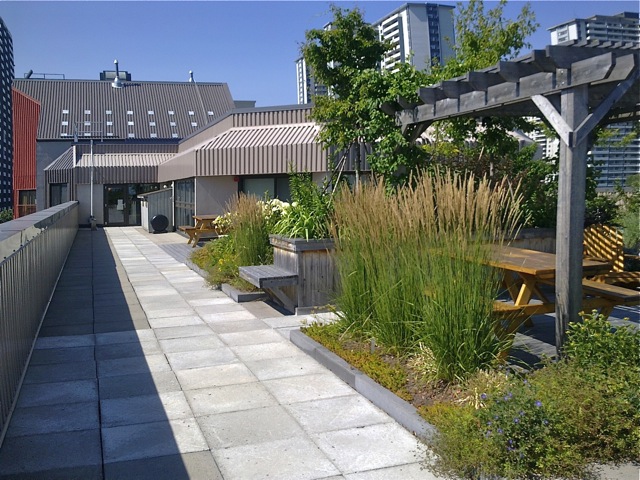 Walkway from the roof garden entrance Walkway from the roof garden entrance to the gazebo  Beata Domanska in the gazebo Beata Domanska in the gazebowith the city as background 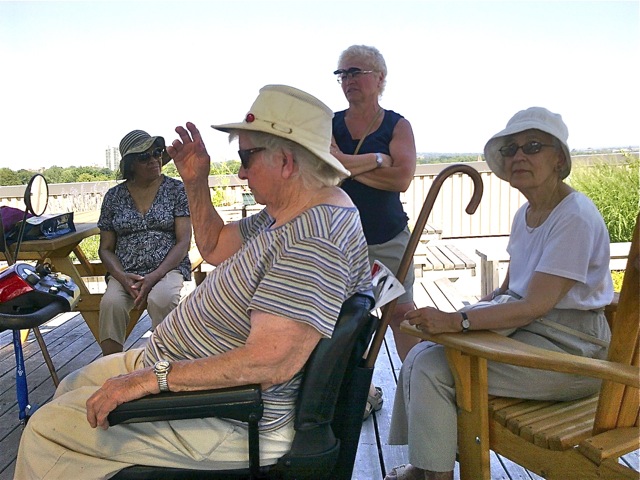 Eleanor McDonald and her new red scooter Eleanor McDonald and her new red scooter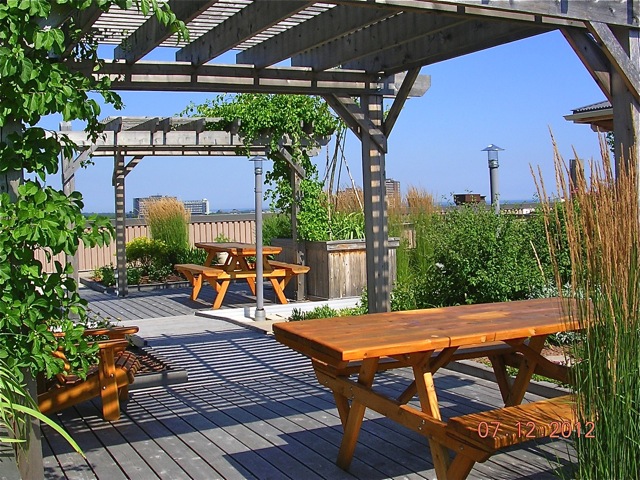 Scattered tables encourage sociability Scattered tables encourage sociability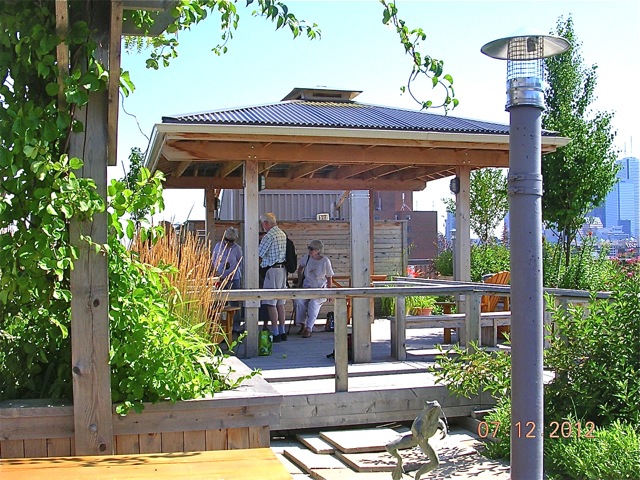 Sheltering from the sun in the raised gazebo Sheltering from the sun in the raised gazebo A ramp up to the gazebo makes access easy A ramp up to the gazebo makes access easy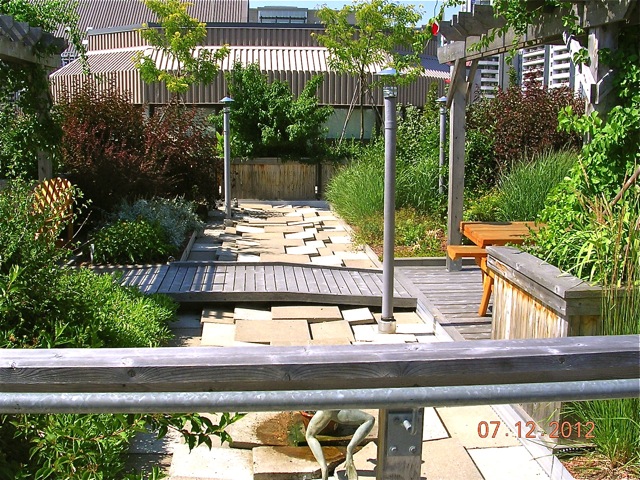 At the centre of the garden, a tempting path…. At the centre of the garden, a tempting path…. |
Back to Housing Tours page.
Page last updated: August 26, 2013
